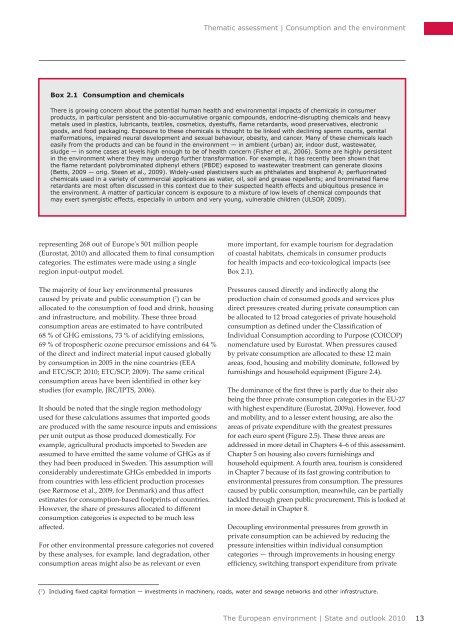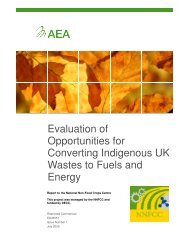Consumption and the environment (SOER2010) - European ...
Consumption and the environment (SOER2010) - European ...
Consumption and the environment (SOER2010) - European ...
Create successful ePaper yourself
Turn your PDF publications into a flip-book with our unique Google optimized e-Paper software.
Thematic assessment | <strong>Consumption</strong> <strong>and</strong> <strong>the</strong> <strong>environment</strong><br />
Box 2.1 <strong>Consumption</strong> <strong>and</strong> chemicals<br />
There is growing concern about <strong>the</strong> potential human health <strong>and</strong> <strong>environment</strong>al impacts of chemicals in consumer<br />
products, in particular persistent <strong>and</strong> bio-accumulative organic compounds, endocrine-disrupting chemicals <strong>and</strong> heavy<br />
metals used in plastics, lubricants, textiles, cosmetics, dyestuffs, flame retardants, wood preservatives, electronic<br />
goods, <strong>and</strong> food packaging. Exposure to <strong>the</strong>se chemicals is thought to be linked with declining sperm counts, genital<br />
malformations, impaired neural development <strong>and</strong> sexual behaviour, obesity, <strong>and</strong> cancer. Many of <strong>the</strong>se chemicals leach<br />
easily from <strong>the</strong> products <strong>and</strong> can be found in <strong>the</strong> <strong>environment</strong> — in ambient (urban) air, indoor dust, wastewater,<br />
sludge — in some cases at levels high enough to be of health concern (Fisher et al., 2006). Some are highly persistent<br />
in <strong>the</strong> <strong>environment</strong> where <strong>the</strong>y may undergo fur<strong>the</strong>r transformation. For example, it has recently been shown that<br />
<strong>the</strong> flame retardant polybrominated diphenyl e<strong>the</strong>rs (PBDE) exposed to wastewater treatment can generate dioxins<br />
(Betts, 2009 — orig. Steen et al., 2009). Widely-used plasticisers such as phthalates <strong>and</strong> bisphenol A; perfluorinated<br />
chemicals used in a variety of commercial applications as water, oil, soil <strong>and</strong> grease repellents; <strong>and</strong> brominated flame<br />
retardants are most often discussed in this context due to <strong>the</strong>ir suspected health effects <strong>and</strong> ubiquitous presence in<br />
<strong>the</strong> <strong>environment</strong>. A matter of particular concern is exposure to a mixture of low levels of chemical compounds that<br />
may exert synergistic effects, especially in unborn <strong>and</strong> very young, vulnerable children (ULSOP, 2009).<br />
representing 268 out of Europe's 501 million people<br />
(Eurostat, 2010) <strong>and</strong> allocated <strong>the</strong>m to final consumption<br />
categories. The estimates were made using a single<br />
region input-output model.<br />
The majority of four key <strong>environment</strong>al pressures<br />
caused by private <strong>and</strong> public consumption ( 7 ) can be<br />
allocated to <strong>the</strong> consumption of food <strong>and</strong> drink, housing<br />
<strong>and</strong> infrastructure, <strong>and</strong> mobility. These three broad<br />
consumption areas are estimated to have contributed<br />
68 % of GHG emissions, 73 % of acidifying emissions,<br />
69 % of tropospheric ozone precursor emissions <strong>and</strong> 64 %<br />
of <strong>the</strong> direct <strong>and</strong> indirect material input caused globally<br />
by consumption in 2005 in <strong>the</strong> nine countries (EEA<br />
<strong>and</strong> ETC/SCP, 2010; ETC/SCP, 2009). The same critical<br />
consumption areas have been identified in o<strong>the</strong>r key<br />
studies (for example, JRC/IPTS, 2006).<br />
It should be noted that <strong>the</strong> single region methodology<br />
used for <strong>the</strong>se calculations assumes that imported goods<br />
are produced with <strong>the</strong> same resource inputs <strong>and</strong> emissions<br />
per unit output as those produced domestically. For<br />
example, agricultural products imported to Sweden are<br />
assumed to have emitted <strong>the</strong> same volume of GHGs as if<br />
<strong>the</strong>y had been produced in Sweden. This assumption will<br />
considerably underestimate GHGs embedded in imports<br />
from countries with less efficient production processes<br />
(see Rørmose et al., 2009, for Denmark) <strong>and</strong> thus affect<br />
estimates for consumption-based footprints of countries.<br />
However, <strong>the</strong> share of pressures allocated to different<br />
consumption categories is expected to be much less<br />
affected.<br />
For o<strong>the</strong>r <strong>environment</strong>al pressure categories not covered<br />
by <strong>the</strong>se analyses, for example, l<strong>and</strong> degradation, o<strong>the</strong>r<br />
consumption areas might also be as relevant or even<br />
more important, for example tourism for degradation<br />
of coastal habitats, chemicals in consumer products<br />
for health impacts <strong>and</strong> eco-toxicological impacts (see<br />
Box 2.1).<br />
Pressures caused directly <strong>and</strong> indirectly along <strong>the</strong><br />
production chain of consumed goods <strong>and</strong> services plus<br />
direct pressures created during private consumption can<br />
be allocated to 12 broad categories of private household<br />
consumption as defined under <strong>the</strong> Classification of<br />
Individual <strong>Consumption</strong> according to Purpose (COICOP)<br />
nomenclature used by Eurostat. When pressures caused<br />
by private consumption are allocated to <strong>the</strong>se 12 main<br />
areas, food, housing <strong>and</strong> mobility dominate, followed by<br />
furnishings <strong>and</strong> household equipment (Figure 2.4).<br />
The dominance of <strong>the</strong> first three is partly due to <strong>the</strong>ir also<br />
being <strong>the</strong> three private consumption categories in <strong>the</strong> EU‐27<br />
with highest expenditure (Eurostat, 2009a). However, food<br />
<strong>and</strong> mobility, <strong>and</strong> to a lesser extent housing, are also <strong>the</strong><br />
areas of private expenditure with <strong>the</strong> greatest pressures<br />
for each euro spent (Figure 2.5). These three areas are<br />
addressed in more detail in Chapters 4–6 of this assessment.<br />
Chapter 5 on housing also covers furnishings <strong>and</strong><br />
household equipment. A fourth area, tourism is considered<br />
in Chapter 7 because of its fast growing contribution to<br />
<strong>environment</strong>al pressures from consumption. The pressures<br />
caused by public consumption, meanwhile, can be partially<br />
tackled through green public procurement. This is looked at<br />
in more detail in Chapter 8.<br />
Decoupling <strong>environment</strong>al pressures from growth in<br />
private consumption can be achieved by reducing <strong>the</strong><br />
pressure intensities within individual consumption<br />
categories — through improvements in housing energy<br />
efficiency, switching transport expenditure from private<br />
( 7 ) Including fixed capital formation — investments in machinery, roads, water <strong>and</strong> sewage networks <strong>and</strong> o<strong>the</strong>r infrastructure.<br />
The <strong>European</strong> <strong>environment</strong> | State <strong>and</strong> outlook 2010<br />
13








